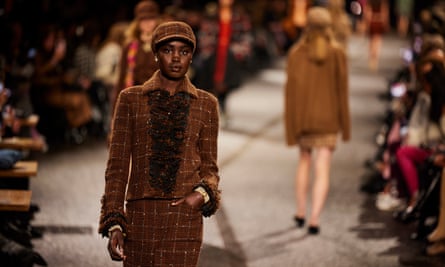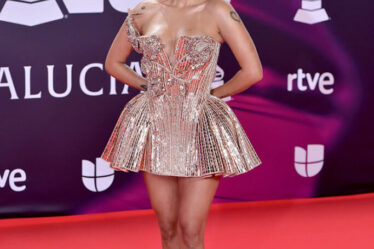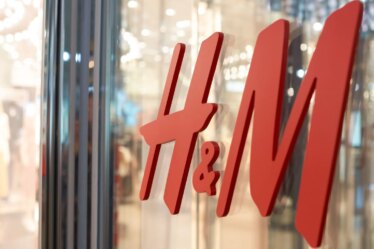
“It is radically unexpected. Truly extraordinary. Genuinely off the wall. It is so superincongruous that it’s weirdly interesting.”
The renowned designer Peter Saville, speaking to the Guardian a few hours before Chanel’s catwalk show, painted quite the picture of the “dynamically unusual” state visit by the most august and courtly of Parisian fashion houses to the rainy streets of Manchester.
A front row that ran past the tattoo parlours, pubs and karaoke bars of the Northern Quarter brought together Tilda Swinton with Gary Neville, and Hugh Grant with John Cooper Clarke. On the street catwalk, the bodice of a cocktail dress was hand-embroidered in concentric circles of jet beads to look like the liquorice-black grooves on a vinyl record, while intarsia cashmere sweaters were plastered in graphics inspired by nightclub flyers. The invitation to the show was a montage of images from Mancunian counter-culture: Saville’s designs for Factory Records; Emmeline Pankhurst, the suffragette, marching with her daughters; the striped walls of the Hacienda; images of the old Granada studios – soon to reopen as the first Manchester outpost of Soho House – and Kevin Cummins’s 1979 photograph of Joy Division on Hulme Bridge.
“This show is an indicator that there is a perception of Manchester out there in the world that is brokered not just by football, and that’s really important,” said Saville. “It’s an interesting endorsement. It’s good for Chanel and it’s good for Manchester.”
After the show, which was protected from the elements by a giant metal canopy supporting a transparent roof, Cummins said: “It had a really great Mancunian feel. It didn’t feel like Chanel had just parachuted in here and chucked in cliches. Everyone I spoke to felt the same way. And I thought it was interesting that it rained. It was proper Mancunian weather, wasn’t it?”
Chris Hoyle, an actor and playwright who conducts historical walking tours of Manchester, noted that football and music were key drivers for most visiting tourists, but that residents value what he called “the Manchester mindset” of original thought in the birthplace of inventions as diverse as the passenger railway station and the ice-cream cone. “We are consistently voted one of the best places to live in the UK, and I don’t think it’s for the weather,” he added.
With several blocks of the city commandeered for days, and a post-show party at the Victoria Baths, where Lancashire hotpot was served before a live set by Primal Scream, the presence of Chanel in the city was inescapable. “There are aspects of this that will irritate some people – even outrage some people,” said Saville. “And that’s very understandable, from a socioeconomic point of view.”

Some protesters gathered close to the show, with placards criticising the insensitivity of holding the extravagant event in a city where many of the population are struggling financially. But the mayor of Greater Manchester, Andy Burnham, although absent on the night due to a trip abroad, was supportive of the event.
Manchester’s footballing prowess was represented by United’s Luke Shaw. Manchester City’s Jack Grealish was reported to have been disappointed that his contract with Gucci prevented him from attending. Many of the Chanel team who travelled with Virginie Viard, the brand’s creative director, to Manchester from Paris showed up with vocal support for Manchester United the night before the show, when a section of the Sir Alex Ferguson stand at Old Trafford rang with cries of “Allez!” during a 2-1 victory over Chelsea.
The show proved that the music story that came out of the city 40 years ago retains pop cultural glamour. On the morning of show day, the vintage stores of Oldham Street were packed with French fashion editors shopping for 1980s band T-shirts.
“It makes sense, because Factory Records was never just a music story,” said Saville. “I have sometimes referred to it as a designer label. The Factory logo was gritty and industrial, but it was done with a lot of style and polish. It was actually very sophisticated.”

The importance of aesthetics in the era of Manchester’s musical pomp was echoed by Cummins, who has said of his famous image of Joy Division, in which the band, standing on the far side of the bridge, look the size of Lowry matchstick men, that “what I was trying to do here was capture the sound”.
“Manchester is the original modern city, and in the history of fashion it is probably Coco Chanel who defines original modern more than anyone else, in that she designed a new way of life for women,” said Saville. “So in a way the two spirits are not as far apart as the surface realities might appear.”
Nostalgia for the Hacienda dancefloor was counterbalanced by pride in Manchester’s development as a diverse city. “I was talking with [the Manchester author] Paul Morley tonight, and we were saying that in 1977 we used to go to the Ranch Bar, which is about 100 yards from here, because it was the only place in Manchester that it was safe to be a punk,” remembered Cummins. “Walking home then, we’d be genuinely scared for our lives. The city has moved on a lot from those days, and tonight was a celebration of that.”
“Great clothes. Fabulous,” was the verdict from Clarke, as he left the show with his wife, Evie. “Thank you very much – to the House of Dior!” he added, signing off with a Manchester deadpan flourish.



